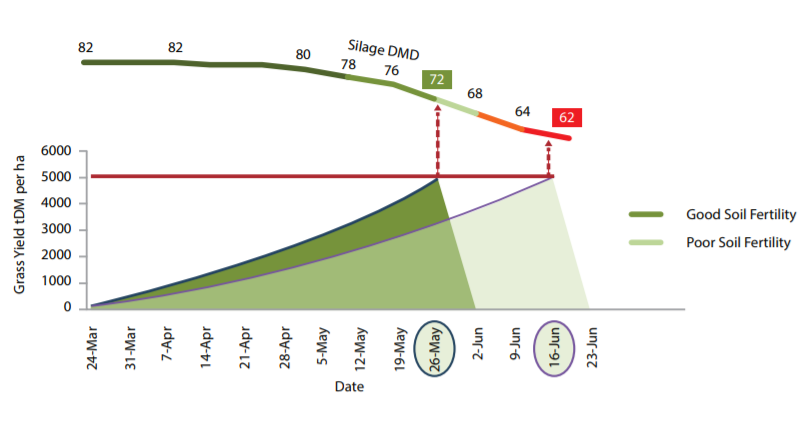After the winter/spring just passed, fodder reserves on farms across the country are at low levels and this brings the challenge of building sufficient supplies for the coming winter.
Over recent days and weeks, grass growth rates have finally started to edge upwards; growth rates of 62kg/ha, 67kg/ha, 57kg/ha and 74kg/ha have been recorded in the provinces of Connacht, Munster, Ulster and Connacht respectively.
Where possible, dairy farmers should look to increase the stocking rate on the milking platform to 4.0-4.5 cows per hectare, while also shortening the length of the grazing rotation.
This will present farmers with an opportunity to close up additional paddocks for silage or, where possible, farmers should consider taking paddocks with strong covers (>1,500kg/ha) out as surplus bales.
Where the latter tactic is employed, farmers must ensure that they have sufficient grass ahead of their cows to avoid the risk of falling into a grass deficit.
When it comes to silage ground, farmers should aim to apply 100un/ac of nitrogen and 10un/ac of sulphur to generate sufficient yields. Remember, the single biggest factor contributing to the cost is the yield of the crop.
And with the weather that’s forecast for the coming week, farmers may be presented with the ideal opportunity to top dress grass swards with nitrogen and sulphur.
However, to ensure the crop ensiles well, it’s worth remembering that a grass crop uses approximately 2un/day of nitrogen during peak growth periods. If you have any doubts about the quantity of nitrogen present in your grass sward prior to cutting, get it tested.
Quantity versus quality
At farm level, the primary challenge for farmers is to maximise silage yield, while – at the same time – achieving the target silage quality for the production system on their farm.
According to Teagasc, the capacity to maximise DM (dry matter) yield per cut is limited by the effect of growth stage on grass quality.
Delaying harvest to ‘bulk up’ crops will increase DM yield. However, digestibility declines sharply after grass heading date such that the total yield of digestible feed in the crop does not increase further; removal of the crop is necessary to promote new growth.
Therefore, it’s critical to match what you are feeding your silage to with the cutting date; high-production animals – such as cows in milk over the winter months – will require high-quality silage (+75 DMD), whereas dry cows will have a lower nutritional requirement and average-quality silage (69 DMD) will be sufficient as long as the diet is balanced.
Work carried out in Teagasc Grange indicated that delayed cutting date has a negative consequence on the quality achieved.
The work illustrated that quality falls rapidly after grass heading date (0.5 DMD units per day) and when it comes to producing high DMD silage, farmers should aim to mow as the seed heads begin to emerge.
To bulk up feed reserves, a second cut may also be required this year and it’s imperative that cutting isn’t delayed. Failing to have your first-cut silage cleared by early June could create unnecessary difficulties when it comes to saving the second cut.

